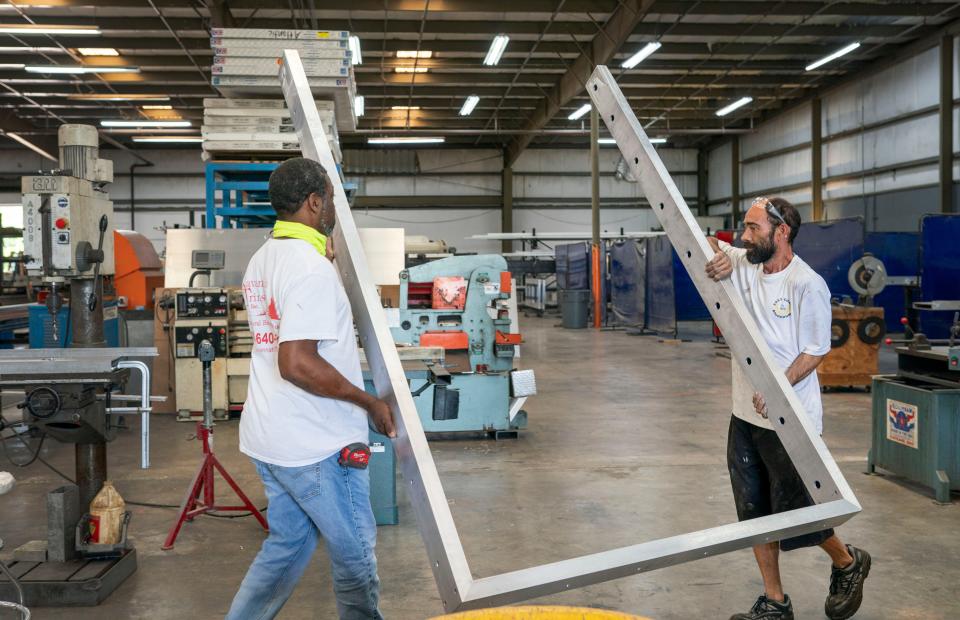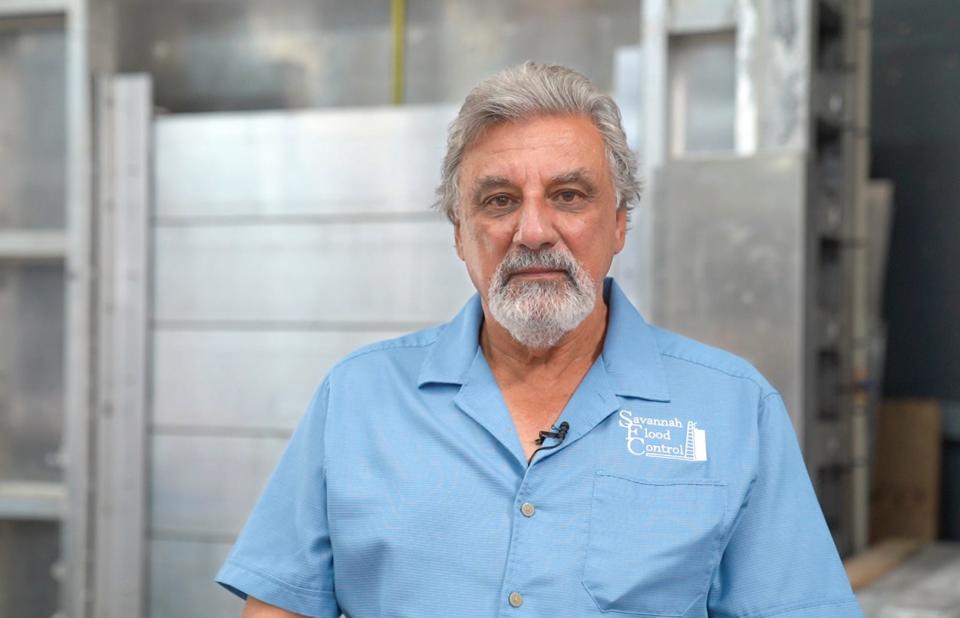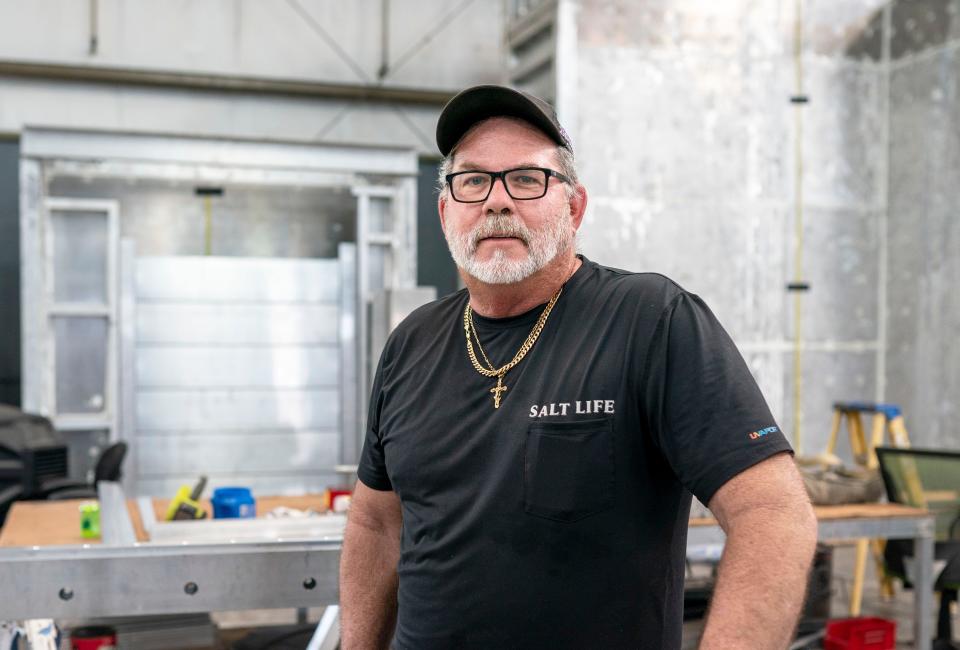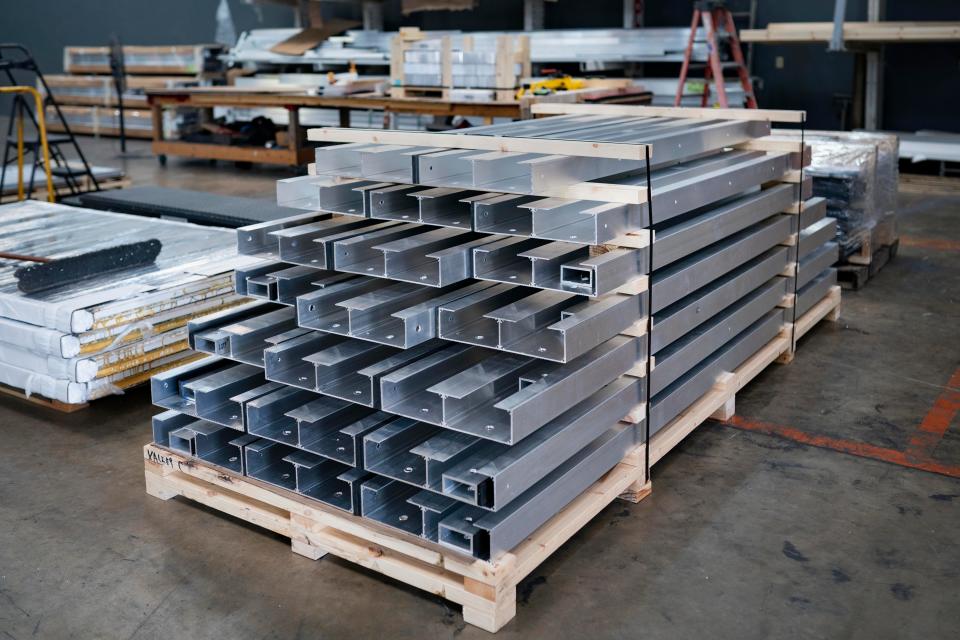These guys in Riviera Beach are leading the charge against climate change
This article is part of a USA TODAY Network reporting project called "Perilous Course," a collaborative examination of how people up and down the East Coast are grappling with the climate crisis. Journalists from more than 35 newsrooms from New Hampshire to Florida are speaking with regular people about real-life impacts, digging into the science and investigating government response, or lack of it.
Gene Kennedy knew he’d joined a different type of business when he was sent in 2004 on his first flood control project to protect a Key West senior citizen home from encroaching seas.
The solution was removable flood barriers – metal panels like hurricane shutters that could be installed between posts in the ground when bulging high tides threatened to overflow.
“I had never done anything like that before,” Kennedy said. “I took 20 pages of notes, I was so afraid of getting something wrong.”
It would prove to be prophetic.
Even back then, the small business was innovating actively from its unassuming origins in the 1980s South Florida building boom to a business leader in creating bulwarks against torrential rains, swollen tides and surging waves amplified by climate change.
Dennis Dudash founded the company Savannah Trims nearly four decades ago selling decorative skylights and miscellaneous architectural adornments. Now 80, the Palm Beach Gardens resident never dreamed it would evolve into what it is today.
“When it came to flood control products, I couldn’t imagine it at first,” Dudash said. “They were just panels we bolted to the floor and wall, but I understood the potential.”
More from Perilous Course: Sea level rise threatened to swallow a Palm Beach historic home, she vowed to save it
And: Can mangrove plants tackle climate change? These West Palm Beach growers say they can

Their products help protect a NYC museum, Miami hotel, Boston dam and Arizona student housing
The company’s warehouse off Avenue R in Riviera Beach is a grown-up industrial arts class with welding bays and stacks of sheet metal and a glass glazing machine that looks like a floor mixer in a commercial kitchen. There’s a top secret project patent pending, and steel tanks 10 feet overhead that are filled with water to test the integrity of inventions that guard some of the country’s most valuable assets.
Dudash sold the company to a partner in 2016 as the occupation of keeping commerce dry became a growing industry with water-driven disasters increasing, including seven billion-dollar plus flooding catastrophes in 2021 partly seeded by the stalling tropical cyclones and heavier rainfalls of a world baking in greenhouse gases.
The devices from what is now called Savannah Flood Control defend the Sept. 11 Memorial Museum in New York, the Gran Paraiso Hotel in Miami, the Amelia Earhart Dam on the Mystic River in Boston and student housing at Arizona State University.
The company was supercharged by the need for hurricane protection after Category 5 Andrew ground Homestead into sticks and chaos in 1992.
But the collaboration that grew Dudash’s company to a powerhouse design and manufacturing flood-control firm was organic — a collision of atmospheric tirades and occupational speed bumps.

Kennedy, 68, now owns Savannah. He's a former Army combat engineer who had experience in special window systems as well as exterior sun control levers and technical blinds after his service ended in 1980.
Gregory Miller, 63, worked at Pratt & Whitney as a metal spinner — a highly specialized combination of a machinist and pattern maker. When he got laid off, he focused on his own company, East Coast Aluminum, which now works with Savannah in the same Avenue R warehouse to design, make and install the flood-control products.
Richard Romero, 59, taught college architecture classes at Lincoln College, formerly New England Institute of Technology. When the school's West Palm Beach branch closed after the 2008 recession, he was hired at Savannah and is its senior design and project manager.
Business slowed when COVID hit, but it is picking up again with new construction gaining ground and retrofits needed to century-old structures grappling to meet FEMA standards. As the activity grew, so did the size and complexities of the projects.
“When Gregg and I took over, we said we would tackle these larger projects,” Kennedy said. “We’re doing things that have never been done before.”
One New York customer wants flood control glass to front a building that is 10 feet wide and 21 feet tall. Each glass is 4,000 pounds.
Another door had to withstand 27 feet of moving headwater as well as a 1,000-pound log floating at 5 to 8 feet per second. In American Samoa, Savannah designed, engineered and built a 12-foot-wide and 8-foot-tall flood gate to protect the Satala Power Plant — one of the company’s largest projects.
Savannah’s removable flood fences are at the Apple store at the Aventura Mall. Its glazed flood glass barriers protect Virginia’s Roanoke Memorial Hospital Carilion Clinic. And its drop-down doors guard New Jersey Transit’s train maintenance facilities.
The New Jersey Train Maintenance Depot was a $3.2 million job.
“Every project is unique,” Kennedy said.
The company was altered by Hurricane Andrew and Superstorm Sandy

It was two hurricanes, 20 years apart, that shaped the company.
Category 5 Hurricane Andrew was the first storm of the 1992 storm season, making landfall Aug. 24. There was little buildup to the fury. Andrew was the first hurricane to form from a tropical wave in nearly two years and building codes hadn’t kept up with what the atmosphere summoned.
Just three days before reaching the coast, Andrew was a small tropical storm, but it would deepen to a 174-mph Category 5. Its 5:05 a.m. landfall brought sustained winds of 165 mph that destroyed about 49,000 homes. An additional 108,000 were damaged.
“Andrew drove the business along,” Dudash said. “Dade County was looking for solutions and when new building codes passed, my phone started ringing.”

In case you missed it: The man who duels with swordfish is alarmed: Famous fisherman sees worrisome ocean changes
And: Rising seas threaten Florida’s historical sites. This archaeologist wants to fight back.
He got together with some other glass guys and started experimenting with 2x4s shot out of air-pressurized cannons at specially-glazed windows to test their mettle. He’s a salesman, not an engineer, but he wanted to know where weak spots were to better market hurricane-resistant products.
That's since evolved into sending a 1,000-pound log into barriers that now guard for wind and flood.
In 2012, Superstorm Sandy formed. The system was downgraded from a hurricane to a post-tropical cyclone when it made landfall Oct. 29 north of Atlantic City, but it was no less fearsome.
Its devastating reach included 24 states and carried a storm surge that hit New York City with an unstoppable saltwater assault. The ocean flooded streets, tunnels and subway lines, cutting power around the city.
Sandy ushered in new rules for flood protection.
Company follows what the scientists are predicting for climate change

Scientists are reluctant to single out any one hurricane as the product of climate change. But most researchers agree the conduct of these storms, including flooding rains, escalating intensities and a swollen storm surge riding on rising seas is consistent with what climate change models predict will happen more often as the world warms.
NOAA's Geophysical Fluid Dynamics Laboratory recently issued a 20-page synopsis of current research results about global warming and hurricanes.
In summary, it says sea-level rise, "which very likely has a substantial human contribution," will cause higher coastal inundation levels for tropical cyclones. That means bigger waves and higher storm surge that reaches farther inland.
Storm intensities are projected to increase by 1-10% with a 2 degrees Celsius or 3.6 degrees Fahrenheit increase. Storm rainfall rates are also expected to increase 10-15%.
Many buildings in the Northeast are now constructed at higher elevations, and with defenses against water such as sealed reinforced glass because of Sandy.
"It's exciting to say we did the 911 memorial," Miller said. "Not many people can say they've done something like that, and we're doing it right here in Riviera Beach."
Older buildings and bridges and tunnels need retrofits, and that business was also a boon for Savannah Flood Protection after Sandy. Structures have to be fortified to handle a slowly rising flood and a crashing surge that will send cars — and all matter of other debris — careening through streets.
“I call it engineering in motion,” said Richard Romero, Savannah’s senior design and project manager when talking about calculating the variables of water, force, structure frame and glass type in plans. “These are things architects didn’t have to think about in the past.”
They invent new flood protection strategies every day, solving problems
But that’s also what keeps the job exciting, Romero said. They are inventing new flood protection strategies every day, working on patents and solving problems.
Dudash named his company Savannah Trims after a Ford ragtop he and his friends drove from Detroit to Fort Lauderdale in the late 1950s ran out of gas in the coastal Georgia city. He thought the name sounded romantic and it piqued customers’ interests when he cold-called them to solicit business. It was a time before construction bids were made online, and computer software drew precise 2D and 3D models and before the climate crisis was dinner-table conversation.
And while the men at Savannah Flood Control don’t wear environmentalism on their sleeves or frequently talk about global warming or bemoan a lack of progress at the COP26 climate conference, they do believe in climate change.
“I see it happening. I don’t like to run around saying the sky is falling, but something is wrong with the planet,” Dudash said.
Kennedy said he sees problems ahead, too.
“If the scientists are even half right about the predictions, we are in for problems," he said.
Kimberly Miller is a veteran journalist for The Palm Beach Post, part of the USA TODAY Network of Florida. She covers real estate and how growth affects South Florida's environment. If you have news tips, please send them to kmiller@pbpost.com.
This article originally appeared on Palm Beach Post: Global warming: Riviera beach firm evolved to meet needs of climate change

